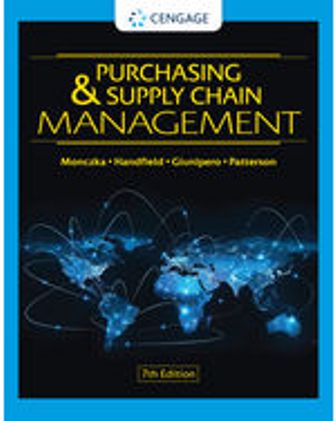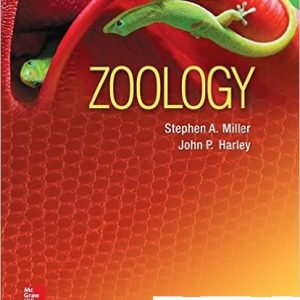This is completed downloadable of Test Bank for Purchasing and Supply Chain Management, 7th Edition, Robert M. Monczka, Robert B. Handfield, Larry C. Giunipero James L. Patterson
Product Details:
- ISBN-10 : 0357442148
- ISBN-13 : 978-0357442142
- Author:
Gain a thorough understanding of today’s supply management process from a managerial perspective with the current, complete coverage found in PURCHASING AND SUPPLY CHAIN MANAGEMENT, 7E. This edition draws from the authors’ extensive first-hand experiences and relationships with executives and practitioners worldwide to highlight critical developments in the field. You examine recent advancements in supply chain fraud management, artificial intelligence, analytics, procurement automation and robotic process automation. New content also discusses supply chain fraud management and mitigation, emerging technology in real-time supply chain control towers, use of blockchain and the creation of Centers of Excellence. Carefully selected topics correspond to hiring requirements for supply chain positions today to help position you as a strong candidate. Former students agree that this book provides solid preparation for successfully entering today’s workforce in procurement and supply management.
Table of Content:
- Part 1: Introduction
- Chapter 1: Introduction to Purchasing and Supply Chain Management
- 1-1 Introduction
- 1-2 A New Competitive Environment
- 1-3 Managing the Supply Base
- 1-4 Why Purchasing Is Important
- 1-5 Understanding the Language of Purchasing and Supply Chain Management
- 1-6 Achieving Purchasing and Supply Chain Benefits
- 1-7 The Supply Chain Umbrella-Functional Activities
- 1-8 Four Enablers of Purchasing and Supply Chain Management
- 1-9 The Evolution of Purchasing and Supply Chain Management
- 1-10 Looking Ahead
- Part 2: Purchasing Operations and Structure
- Chapter 2: The Purchasing Process
- 2-1 Introduction
- 2-2 Purchasing Objectives
- 2-3 Strategic Supply Management Roles and Responsibilities
- 2-4 Improving the Procure-to-Pay Process
- 2-4k Bidding or Negotiating?
- 2-5 Approval, Contract, and Purchase Order Preparation
- 2-6 Types of Purchases
- Chapter 3: Purchasing Policy and Procedures
- 3-1 Introduction
- 3-2 Policy Overview
- 3-3 Purchasing Policies – Providing Guidance and Direction
- 3-4 Purchasing Procedures
- Chapter 4: Supply Management Integration for Competitive Advantage
- 4-1 Introduction
- 4-2 Integration: What Is It?
- 4-3 Internal Integration
- 4-4 External Integration
- 4-5 The Critical Role of Cross-Functional Sourcing Teams
- 4-6 Integrating Supply Management, Engineering, and Suppliers to Develop New Products and Services
- 4-7 Potential Benefits of On-Site Supplier Representatives
- Chapter 5: Purchasing and Supply Management Organization
- 5-1 Introduction
- 5-2 P/SM Organizational Structure
- 5-3 Location of Authority Centralized or Decentralized
- 5-4 Purchasing’s Position within the Organizational Structure
- 5-5 Scope of the Purchasing/Supply Management Job Function
- 5-6 Purchasing/Supply Management Job Tasks
- 5-7 Separating Strategic and Operational Purchasing
- 5-8 Using Teams as Part of the Organizational Structure
- 5-9 Supply Chain Management Structure
- 5-10 Future Trends in Organizational Design
- Part 3: Strategic Sourcing
- Chapter 6: Category Strategy Development
- 6-1 Introduction
- 6-2 Aligning Supply Management and Enterprise Objectives
- 6-3 What Is a Category Strategy?
- 6-4 Category Strategy Development
- 6-5 Types of Supply Management Strategies
- 6-6 Supply Management Transformation Evolution
- Chapter 7: Supplier Evaluation and Selection
- 7-1 Introduction
- 7-2 The Seven-Stage Supplier Evaluation and Selection Process
- 7-3 Recognize the Need for Supplier Selection – Stage 1
- 7-4 Identify Key Sourcing Requirements – Stage 2
- 7-5 Identify Potential Supply Sources – Stage 3
- 7-6 Determine Sourcing Strategy – Stage 4
- 7-7 Limit Suppliers in the Selection Pool – Stage 5
- 7-8 Conduct a Detailed Review of Supplier Evaluation Criteria – Stage 6
- 7-9 Select Supplier and Reach Agreement – Step 7
- 7-10 Developing a Quantitative Supplier Evaluation Survey
- 7-11 Reducing Supplier Evaluation and Selection Cycle Time
- Chapter 8: Supplier Quality Management
- 8-1 Introduction
- 8-2 Overview of Supplier Quality Management
- 8-3 Factors Affecting Supply Management’s Role in Managing Supplier Quality
- 8-4 Supplier Quality Management Using a Total Quality Management Perspective
- 8-5 Pursuing Six Sigma Supplier Quality
- 8-6 Using ISO Standards and MBNQA Criteria to Assess Supplier Quality Systems
- 8-7 Basic Contents of a Supplier Quality Manual
- Chapter 9: Supplier Management and Development: Creating a World-Class Supply Base
- 9-1 Introduction
- 9-2 Supplier Performance Measurement
- 9-3 Rationalization and Optimization: Creating a Manageable Supply Base
- 9-4 Supplier Development: A Strategy for Improvement
- 9-5 Overcoming the Barriers to Supplier Development
- 9-6 Managing Supply Base Risk
- 9-7 Managing Sustainability in the Supply Base
- Chapter 10: Worldwide Sourcing
- 10-1 Globalization – Changing Supply Strategy in a Dynamic World Economy
- 10-2 Changing Global Dynamics Create Challenges
- 10-3 Worldwide Sourcing Timeline
- 10-4 Developing a Worldwide Sourcing Program
- 10-5 Moving to a Global Sourcing Philosophy
- Part 4: Strategic Sourcing Process
- Chapter 11: Strategic Cost Management
- 11-1 Introduction
- 11-2 A Structured Approach to Cost Reduction
- 11-3 Price Analysis
- 11-4 Cost Analysis Techniques
- 11-5 Building a Should-Cost Model
- 11-6 Total Cost of Ownership (TCO)
- 11-7 Collaborative Approaches to Cost Management
- Chapter 12: Purchasing and Supply Chain Analysis: Tools and Techniques
- 12-1 Introduction
- 12-2 Project Management
- 12-3 Learning-Curve Analysis
- 12-4 Value Analysis/Value Engineering
- 12-5 Quantity Discount Analysis
- 12-6 Process Mapping
- 12-7 Value Stream Mapping
- Chapter 13: Negotiation and Conflict Management
- 13-1 Introduction
- 13-2 What Is Negotiation?
- 13-3 The Negotiation Framework in Supply Management
- 13-4 Negotiation Planning
- 13-5 Power in Negotiation
- 13-6 Concessions
- 13-7 Negotiation Tactics: Trying to Reach Agreement
- 13-8 Win-Win Negotiation
- 13-9 International Negotiation
- 13-10 Selected Countries
- 13-11 The Impact of Electronic Media on Negotiations
- Chapter 14: Contract Management
- 14-1 Introduction
- 14-2 Elements of a Contract
- 14-3 How to Negotiate and Write a Contract
- 14-4 Types of Contracts
- 14-5 Fixed-Price Contract with Redetermination
- 14-6 Fixed-Price Contract with Incentives
- 14-7 Long-Term Contracts in Alliances and Partnerships
- 14-8 Nontraditional Contracting
- 14-9 Settling Contractual Disputes
- Chapter 15: Purchasing Law and Ethics
- 15-1 Introduction
- 15-2 Legal Authority and Personal Liability of the Purchasing Manager
- 15-3 Contract Law
- 15-4 The Uniform Commercial Code
- 15-5 Patents and Intellectual Property
- 15-6 Other Laws Affecting Purchasing
- 15-7 Purchasing Ethics
- 15-8 Corporate Social Responsibility
- Part 5: Critical Supply Chain Elements
- Chapter 16: Lean Supply Chain Management
- 16-1 Introduction
- 16-2 Understanding Supply Chain Inventory
- 16-3 The Right Reasons for Investing in Inventory
- 16-4 The Wrong Reasons for Investing in Inventory
- 16-5 Creating the Lean Supply Chain
- 16-6 Six Sigma
- 16-7 Approaches for Managing Inventory Investment
- 16-8 Delivering the Perfect Customer Order
- Chapter 17: Purchasing Services
- 17-1 Introduction
- 17-2 Transportation Management
- 17-3 Outsourcing Logistics Requirements to Third-Party Logistics Providers
- 17-4 Purchasing Services and Indirect Items
- 17-5 Sourcing Professional Services
- Chapter 18: Supply Chain Information Systems and Electronic Sourcing
- 18-1 Introduction
- 18-2 Evolution of E-SCM Systems
- 18-3 An Overview of the E-Supply Chain
- 18-4 Drivers of New Supply Chain Systems and Applications
- 18-5 Internal Information Systems – Enterprise Resource Planning
- 18-6 Purchasing Databases and Data Warehouses
- 18-7 Electronic Data Interchange – Pioneering External Electronic Communication
- 18-8 E-Sourcing Basics
- 18-9 E-Sourcing Models – The External Information Systems
- 18-10 E-Sourcing Suites – General
- 18-11 E-Sourcing Suites – Supplier Relationship Management
- 18-12 Social Networking and the Cloud
- 18-13 Information Visibility in SCM
- 18-14 Collaboration and Big Data
- 18-15 Transformational Technologies
- Chapter 19: Performance Measurement and Evaluation
- 19-1 Introduction
- 19-2 Purchasing and Supply Chain Performance Measurement and Evaluation
- 19-3 Purchasing and Supply Chain Performance Measurement Categories
- 19-4 Developing a Performance Measurement and Evaluation System
- 19-5 Performance Benchmarking: Comparing against the Best
- 19-6 A Summary of Purchasing Measurement and Evaluation Characteristics
- Part 6: Future Directions
- Chapter 20: Purchasing and Supply Strategy Trends
- 20-1 Introduction
- 20-2 Supply Chain Trends
- 20-3 Supply Chains Are Getting Shorter and Local
- 20-4 Different Industries Change Differently
- 20-5 Digitization and Changing Nature of Supply Chains
- 20-6 Trend Forecasts: Business, Research Organizations, and Academics
- 20-7 Critical Future Supply and Supply Chain Strategies
- 20-8 Expanding the Mission, Goals, and Performance Expectations
- 20-9 Developing Category Strategies Will Become Broader and More Complex
- 20-10 Supplier Management across the Extended Supply Chain
- 20-11 Designing and Operating Multiple Customer-Focused Supply Networks
- 20-12 Leveraging E-System Technology Enablers Takes on Additional Focus
- 20-13 Collaborating Internally and Externally Will Grow in Strategic Importance
- 20-14 Attracting, Developing, and Retaining Supply Management Talent Will Become a Key Differentiato
- 20-15 Managing and Enabling the Future Supply Management Organization and Measurement Systems
- 20-16 Twelve High-Impact Sourcing and Supply Chain Strategies for 2020-2025
- Cases
- Case 1: Avion Inc
- Case 2: The Global Sourcing Wire Harness Decision
- Case 3: Managing Supplier Quality: Integrated Devices
- Case 4: Negotiation – Porto
- Case 5: Purchasing Ethics
- Case 6: Insourcing/Outsourcing: The FlexCon Piston Decision
- Case 7: Email Exercise
- Index





